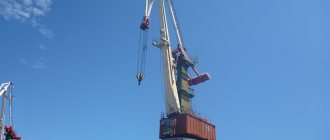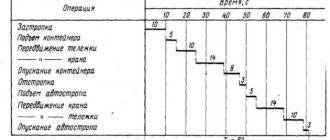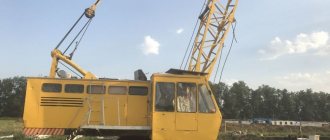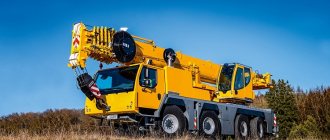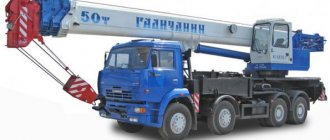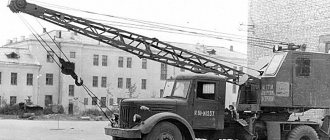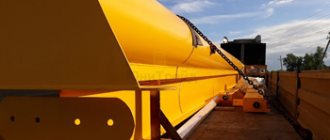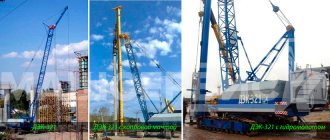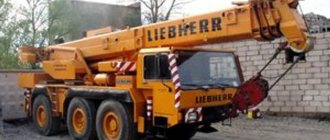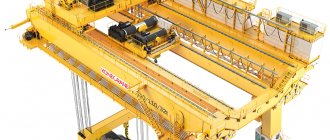Portal cranes. Description. Characteristics
1.1 .
Reloading portal cranes. A portal crane is a complex lifting and transport machine, the complexity of the design of which is determined by the complexity of technological operations and increased requirements for the precision of execution and operation of the crane.
Figure 1 – Portal crane. General form.
1-way trolley; 2-portal; 3-support rotating device; 4-fixed counterweight; 5-control cabin;6-cabinet for mechanisms;7-mechanism for changing reach;8-movable counterweight;9-boom;10-rigid guy ;11-trunk;12-shift working equipment;
1.2 Classification of portal cranes according to their purpose
Portal cranes according to their functional purpose are divided into: reloading, installation, construction, shipbuilding (Fig. 2)
Figure 2 – Block diagram of the classification of portal cranes
1.3 Reloading portal cranes
Port cranes. The lifting capacity of cranes used in ports for loading bulk cargo ranges from 1.5 to 20 tons. With a lifting capacity of over 3 tons, they are usually equipped with replaceable equipment - grabs for working with bulk cargo and hooks for working with piece cargo. For cranes with a lifting capacity of up to 3 tons, inclusive, the use of grabs is very limited; they are mainly used to supply coastal and river vessels with coal. Therefore, to simplify the lifting mechanism, such cranes are usually manufactured only with hooks. For specialized sea berths with large quantities of bulk cargo, it is advisable to use grab cranes with a lifting capacity of up to 25 tons.
Harbor cranes usually have a constant lifting capacity at all ranges. Depending on the width of the border warehouses and the vessels being serviced, harbor cranes have a maximum reach of 15 to 40 m (and 30 m is usually 25). The minimum overhang is taken for design reasons. In order to service the largest area from one crane installation, you should strive to have this reach as small as possible. The gauge width of the portal (the distance between the axes of the crane rails depends on the number of railway tracks covered by the portal. Typically, portals are single-track, three-track, double-track, etc. In some cases, portals are replaced by L-shaped half-portals, in which the horizontal frame of the metal structure on one side rests directly on the running bogies, riding on crane rails laid on the supporting structures of buildings near the warehouses (Fig. 3) or on special overpasses.In river ports with slope embankments, specially designed semi-portals are sometimes used that move along rails laid
Figure 3 – Semi-gantry crane
at different levels (Fig. 4). This allows the crane’s rotation axis to be brought closer to the vessel being unloaded, without resorting to the construction of expensive massive embankment walls. When there are large fluctuations in the water level in the river during floods, the running trolleys running on the lower rail and part of the metal structure of the half-portal often work under water.
The rotating part of the crane on a single-track portal is installed in the middle of its span; on a double-track it is sometimes shifted to one of the crane rails, depending on the operating conditions of the crane. The rotating part of the crane on a three-track portal is sometimes made mobile, which increases the serviced area, but complicates the design of the crane.
Due to the high cost of constructing crane tracks and embankments, the pressure on the running wheels of cranes is usually limited to 20-30 tons. Depending on this pressure, the number of running wheels is determined.
Figure 4 – Reloading gantry crane on a specially designed half-gantry
Possibility of using portal cranes to perform a wide range of operations:
▬ transshipment of piece goods using a cargo hook;
▬ working with heavy loads;
▬ handling bulk cargo using a grab;
▬ working with a magnet;
▬ reloading scrap metal using a rectangular grab;
▬ processing containers using a spreader.
Cranes with a hopper (kangaroo-type cranes) on the portal (Fig. 5) are used for unloading bulk cargo from ships with a stable cargo flow.
Rotation is eliminated from the crane's operating cycle, thereby increasing productivity. The movement of the grab from the hold to the bunker and back is ensured only by the mechanisms of lifting and changing the reach. From the grab
Figure 5 – Portal cranes with a hopper (kangaroo type)
the cargo is poured into a bunker and delivered to the warehouse by conveyors, one or two of which are mounted on a crane. The dimensions of the bunker in plan, taking into account the swinging of the grab on the ropes, are significant. To reduce swaying, the length of the suspension should be as short as possible. When the crane moves along the vessel, the hopper should not protrude towards the shore rail beyond the overall dimensions of the portal. In the crane of the PTO plant named after. S. M. Kirov (Fig. 5, a) the bunker is made rotating. When unloading cargo from a ship, the bunker is installed horizontally, and when the crane moves along the pier - vertically; in this case, the bunker does not touch the superstructure of the vessel. In the crane, for the same reasons, the hopper is made mobile (Fig. 5, b). This allows you to reduce the length of movement of the grab and the weight of the boom system.
The diversity of portal designs is explained by the variety of requirements for portals and cranes, differences in the traditions and experience of crane-building enterprises and little knowledge of the boundaries of the rational use of portal structures. Portals differ in the type of connection of the supports to the upper crossbar (hinged and rigid) in the number of connections to the part (three- and four-support) in the method of forming the structure (lattice, frame (see Fig. 6 a, b) frame-tower (Fig. 6 , c), frame-braced (Fig. 6, d), according to the number of connections of supports to the upper crossbar: two-post (Fig. 6, 6) and four-post (Fig. 6, a), etc. The design of the portal is influenced type of slewing ring: on a multi-roller circle, on a rotary column and on a ball slewing ring.
Figure 6 – Portals: a – four-post frame; b – frame two-post; c – frame-tower; g – frame-braced
Machine series
The French company Potain produces tower cranes in a wide range. The most popular are three series of special equipment. This includes MC, MDT and IGO.
M.C.
Building units of this type are intended for the construction of any structure whose construction period is quite long. A distinctive feature of MC is considered to be very high performance with low energy consumption. The speed of lifting a load in one minute can reach 122 m. At the same time, minor changes in weight do not in any way affect the efficiency of high-altitude work.
You can also note the speed of assembly of the structure. Almost any MC series tower crane model can be put into operation within one shift. This is ensured by unique design solutions in the production of each unit of lifting equipment.
Tower crane Potain MC-235b
The manufacturing process uses high-strength steel grades Q345C and Q345D.
To give maximum stability and rigidity, the entire structure is assembled from square metal. To do this, steel corners are connected by welding. Their size depends on the model of the tower crane and can be 180x180x18 mm or 200x200x20 mm.
Technical data of Potain MC series cranes are presented in the table:
| Model | 175b | 235b | 310 K 12 | 205b |
| Maximum load capacity, t | 8 | 10 | 12 | 10 |
| Load capacity at the end of the boom, t | 1,4 | 2,05 | 3,2 | 2,4 |
| Boom length, m | 60 | 65 | 70 | 60 |
| Lifting height, m | 44,9 | 64,7 | 57,5 | 44,9 |
IGO
This type of lifting structures from Potain is distinguished by its rapid erection.
No special team is needed for its installation. An experienced operator will install the crane himself in 10-15 minutes.
At the same time, he does not need to make any effort, since the IGO series installation is considered self-erecting.
The positive features of such tower cranes include:
- Ease of operation and maintenance. Automated control systems for equipment and cargo allow one operator to cope with all tasks;
- Almost imperceptible power consumption. This figure does not exceed 22 kW;
- Easy to transport around the construction site. To do this, you only need to have a special cart;
- Lack of preparatory work for site construction;
- Compact base. Its dimensions do not exceed 4.5x4.5 m.
Important Features of operation and maintenance of hydraulics on the MTZ-82 tractor: device, diagram, what to do if it breaks
The most common models include IGO 36, 50, 18, 22 and 15 tower cranes.
Tower crane Potain IGO 50
The table shows the characteristics of popular models of Potain tower cranes of the IGO series:
| Model | IGO 36 | IGO 50 | IGO 18 | IGO 22 | IGO 15 |
| Load capacity, t | 4 | 4 | 1,8 | 1,8 | 1,8 |
| Max. lifting capacity at the end of the boom, t | 1,1 | 1,1 | 0,7 | 0,85 | 0,7 |
| Maximum lifting height, m | 22 | 23,2 | 19,1 | 20 | 19 |
| Boom length, m | 32 | 40 | 24 | 28 | 22 |
MDT
This type of lifting equipment is a type without a head. This series is a leader in sales and popularity.
The features of MDT include the ability to change the length of the boom without changing the main components of the structure and the presence of a working space limitation function as standard.
This helps to improve ease of use and achieve maximum safety of surrounding objects.
The positive qualities of MDT series tower cranes include:
- Quickly increase height with fingers up to 300 m;
- A variety of stable bases (cross, chassis or anchor);
- The load lifting speed can reach 114 m/min;
- Convenient transportation due to the small dimensions of the removable sections.
The most popular models in the MDT series include models 178, 98, 128 and 368 L12.
Tower crane Potain MDT-178
Technical parameters of MDT series tower cranes:
| Model | MDT 178 | MDT 98 | MDT 128 | MDT 36 L12 |
| Maximum load capacity, t | 8 | 6 | 6 | 12 |
| Load capacity at max. boom length, t | 1,5 | 1,2 | 1,6 | 3,2 |
| Lifting height, m | 74,5 | 55,1 | 156,3 | 93,7 |
| Maximum boom length, m | 60 | 55 | 55 | 75 |
The video shows a Potain tower crane in action:
https://youtube.com/watch?v=Xq8Y_IoEbRU
Characteristics of the portal crane "Albatross"
The Albatross portal crane is used as the main lifting mechanism in the ports of our country located on the banks of rivers and seas. The balanced technical characteristics of this type of crane equipment allowed the Albatross, which was mass-produced in the GDR, to become a visual symbol of many port facilities. Large industrial production associations with access railway tracks, in some cases, also have this type of crane installations on their balance sheets.
The lifting capacity of the installed hook suspension or other lifting devices (grab of three types, grip with two electromagnetic holders) allows you to work with loads with a total weight of 10 or 20 tons, providing maximum reach respectively from 8 to 32 meters (ten-ton load), from 10 to 16 meters (twenty ton). The technological reach (for maintenance and lubrication) is 6.15 meters.
The portal moves along rail tracks, with the possibility of moving the crane to perpendicular tracks. The most complete technical data, description of the electrical circuit, drawings necessary for operation, and a range of spare parts for repairs are given in the operating instructions.
The price of components and spare parts for regular maintenance depends on the remaining stocks, as well as on the extent to which a particular part is mastered by domestic manufacturers.
Advantages
The advantages of the Sokol portal installation lie in its lifting capabilities and precise adjustment of movement provided by control rollers. This technology makes it possible to reduce the load on crane tracks, reduce wear on mechanisms, and save spare parts. There are also other advantages:
- High accuracy can be achieved through the use of the method of horizontal movement of the object on the boom, which eliminates its swinging.
- The electrical equipment supplies a 380 V network through a cable that meets safety criteria and guarantees the functionality of the crane. Its length does not at all hinder the movement of the lifting unit. The remote control option on modern modifications of installations is provided by a GSM modem.
The price of the mechanisms directly depends on the lifting capacity of the crane. For a completely new unit you need to pay considerable sums - 7–23 million rubles.
To ensure uninterrupted operation of portal equipment, its timely maintenance and replacement of worn-out elements are required. It is imperative to use only original spare parts; many companies that cooperate directly with the manufacturer of the installations offer to buy them.
General description of the crane and technical data
The crane is of the portal reloading type. The main types of work are lifting cargo from sites on the port territory and unloading it into the hold or onto the deck of a cargo ship, as well as the reverse process.
The boom system is defined as an articulated boom with a straight trunk and a rigid guy. This type of boom system is optimal for work in various climatic conditions. The structural reliability of the chosen design has been confirmed by decades of trouble-free operation of cranes in port facilities around the world.
Speeds of implementation of the main operating modes:
- lifting a ten-ton load - 63 meters per minute;
- lifting a twenty-ton load - 32 meters per minute;
- descent - 90 meters per minute;
- change in boom radius - 63 meters per minute;
- horizontal movement of the crane along rail tracks - 32 meters per minute;
- rotation – 1.6 revolutions per minute.
The maximum lifting height of load-handling devices above the rail head for all types of devices used is 22 meters. The exception is a ten-ton hook suspension - 25 meters.
Depth of lowering of various types of grippers from the rail head to the center of the hooks or the bottom plane or edge of specialized grips:
- Hook suspension 10 tons - 15 meters.
- Hook suspension 20 tons - 8 meters.
- Grab - 11 meters.
- Electromagnetic capture – 15 meters.
- The track and base of the portal is 10.5 meters.
- The weight of the crane equipped with a ten-ton hook suspension is 183 tons.
- Electric drive type – three-phase alternating electric current, operating voltage 380 Volts.
- Temperature operating conditions - up to - 30°C.
- The maximum wind speed with a ten-ton load is up to 15 m/sec, with a twenty-ton load – up to 12 m/sec.
Kroll K-10000
The KROLL K-10000 has been one of the world's largest tower cranes for over 40 years. The rack is almost 120 meters high with a boom reach of 85 meters and can lift 120 tons within a radius of almost 90 meters.
The long boom model can lift 94 tonnes to a radius of 95 metres. The K-10000 can rotate 360° after being screwed to a 12 meter diameter concrete base. This allows the crane to cover an area of 7.5 acres, or approximately 6 football fields.
The second, a service crane, is attached to the top for initial assembly and future maintenance of the K-10000. A system of three counterweights, one set and two mobile on trolleys, with a total weight of 100 tons, is used to balance the crane.
Under this load, the crane can withstand wind speeds of up to 108 km/h. With its enormous boom span and lifting capacity, the K-10000 reduces time by eliminating the need for small cranes.
Chassis
The portal part of the crane is equipped with four running trolleys with 16 wheels, half of which are driven. Each trolley has its own electric drive. Traction motors, depending on the year of manufacture of the crane, have a power of 10.5 or 7.3 kW.
Two trolleys are equipped with devices that prevent the crane from colliding with another crane or dead-end movement limiters (stops). To avoid wind theft of the crane in a non-working position, the trolleys are equipped with rail grips.
The running gear of the crane is transferred to perpendicular tracks using a set of hydraulic lifting mechanisms and stands.
Swivel mechanism
The rotating part of the crane, resting on the portal, consists of:
- articulated boom system;
- engine room;
- driver's (crane operator) cabins;
- columns.
The rotation is carried out using two drives located at the bottom of the column, placed on rollers resting on a ring at the top of the portal. The power of each of the two turning motors, depending on the year of production, is 14 kW on earlier, and 19 kW on later series of the crane. The port crane's slewing mechanism is considered reliable and trouble-free if properly maintained.
Design features
Special equipment Sokol is an all-wheel drive portal installation with electric traction. It has a well-thought-out block design in the form of a column that can rotate, equipped with a boom on movable hinges. It is thanks to this design that the horizontal movement of the object is ensured simultaneously with a change in reach.
The unit is controlled by an operator from a comfortable cabin using an autonomous rotating device. Reviews from crane operators about it are the most positive. It allows the attachment to be rotated at right angles.
The equipment has 4 mobile carts for moving along rails. The turning part includes:
- Columns equipped with mechanisms.
- Fixed ballast.
- Controls in the operator's cab.
- The area from which the angle of rotation of the traverse changes.
- The zone from which the arrow's departure angle is changed.
- trunk connected by hinges;
- rigid guy;
- sliding counterweight and rocker arms with additional jibs.
It is the jib that contains a device that reduces wind loads on the attached grab. The installation is also equipped with a drum on which a cable is wound, including a load mechanism.
The machine area of the crane contains:
- Lifting mechanism.
- A system of switchboards with electrical equipment.
A turning mechanism is installed near the base of the column.
Boom system and lifting mechanism
The boom system consists of:
- arrows;
- trunk;
- rigid guy and rocker arm, hingedly connected to each other;
- a counterweight that balances the boom system and is attached to the beam.
The rack and pinion mechanism changes the boom reach. The movement of the outreach in cranes of a similar boom system design ensures almost horizontal movement of the load, which does not require additional adjustments of its position in space.
The mechanism for changing the boom reach is rack and pinion type.
The mechanism is driven by two engines of the same 14 kW power, one of which acts as a drive, and the second as a brake. The motors are connected to the high-speed gearbox shaft by bush-pin couplings, one half of which is made in the form of a brake pulley.
The gear ratio is 63. The low-speed gearbox shaft is connected to a pinion shaft that meshes with the rack.
The mechanism is braked by two double-block brakes with electro-hydraulic pushers. Smooth braking is achieved due to the action of a DC braking motor and a mechanism creating dynamic braking, which leads to a gradual decrease in the rate of change of the boom extension.
The boom, trunk, guy and rocker are made in the form of box-shaped steel structures. Equipped with stairs and platforms for servicing mechanisms and product components.
The mechanism is equipped with three spindle limit switches. The main one is designed to turn off the engine at overhangs of 8 and 32 meters. The preliminary one is activated at overhangs of 9 and 31 meters, and is used to turn on the braking motor, which reduces the speed of change of overhang.
The third switch is designed to work with loads of 20 tons, and operates at reach lengths of 10 and 16 meters. The machine room and control cabin are mounted on the crane column. The machine room has a removable roof for easy installation and dismantling of equipment.
Control circuit
Controls for primary and secondary systems are located in the cab, making the operator's work easier. The general power supply of the systems is started by turning on the main machine; a separate button is provided to check the functionality of the control electrical circuits.
The load-handling mechanisms are controlled by controllers with an asymmetrical circuit and a pedal-type switch. The differential is connected to the grab bucket winch. This element ensures that the electric motor is turned off when raising and lowering the mechanism after opening the bucket.
Operations for lifting and lowering the load are performed by moving the controller levers to the final position. The intermediate position of the joystick is responsible for moving the load grippers over short distances at low speeds.
To close the grab after scooping the load, two control methods are used:
- The pedal is pressed and both controllers move to the extreme position. In this situation, immediately after the bucket jaws close, lifting begins automatically. When the grab crawls up, the pedal is released.
- One of the controller handles is moved to the working position. This is a mechanical mode, and to raise the bucket you need to move the second joystick, aligning it with the first.
Load-handling devices
The crane is equipped with hook hangers designed for loads of up to 10 and 20 tons. The lower-capacity suspension consists of a standard hook with a folding lock, a traverse, and two equalizing ropes.
The twenty-ton suspension is equipped with a two-horn hook and four welded blocks.
For reloading bulk cargo with a bulk weight of 1.2, 2, 2.6 tons per cubic meter, grabs with a capacity of 4, 2.5, 1.6 cubic meters, respectively, are used.
A crossbar with two lifting magnets is suspended on the crane suspension hook. The supply of electric current to the gripper is carried out by a flexible cable. A steel rope runs parallel to the cable from the traverse, preventing the cable from breaking. The necessary cable tension is ensured by a tension trolley.
Video: about the Albatross portal crane.
Portal crane: types and characteristics
The portal crane has the appearance of a special crane, the rotating platform of which is installed on a high pedestal, and the moving mechanism itself moves on rails. These types of devices are often used in shipyards, as well as in ports and ship docks. The basic principle of operation of cranes is to grab and move large-scale loads. The portal crane itself consists of legs, as well as a head. The crane at the port is capable of lifting and moving large-scale cargo weighing from 5 to 300 tons.
Zoomlion ZACB01
A unique truck crane capable of handling 2,000 tons of cargo was created by Chinese designers. Today it is the undisputed leader in lifting equipment and the largest truck crane in the world.
The ZACB01 lifting mechanism is installed on a 12-axle all-wheel drive chassis, allowing the crane to move mobile and reach a speed of 75 km per hour. Full operation of the machine is ensured by 4 diesel engines, and the telescopic boom can extend to 106 meters.
The installed intelligent level control system helps control the colossus weighing 96,000 kilograms. The creation of such a truck crane was caused by new challenges in the construction of large energy facilities, chemical and metallurgical enterprises.
Portal crane device
The portal crane has a base with a driving mechanism capable of rotating around its axis. Since this type of lift is capable of performing a variety of functions, namely moving various types of cargo, it can be equipped with various types of grips, such as a hook or a grab grip. Depending on their location and the functions they perform, cranes can be construction or installation. This type of equipment has a lot of positive characteristics and is also easy to move from place to place.
Types of portal cranes
Portal cranes come in several types and varieties, each of them has its own purpose.
The dock crane, in comparison with similar crane models, has a rather low lifting capacity, which in many ways does not correspond to its intended purpose. This crane is protected from unexpected tip-overs and also has anti-angle grips.
The reloading crane is capable of lifting more weight than the previous one, namely about 30 tons. In some cases, such a lift may be equipped with a special magnet (for lifting metal parts), as well as a hook or grab (for moving bulk cargo). In most cases, such a crane has a winch or several to secure the cargo being moved.
An erection crane is used in ports, as well as at ship repair or shipbuilding enterprises. Externally, such a crane is almost identical to the previous one, only it is capable of lifting loads whose weight can reach 160 tons; several winches are also used for insurance.
Characteristics of cranes
A crane located in a port usually has several operating mechanisms. The traveling mechanism of the crane is the installation function, and all the others are working mechanisms. Depending on the installation location, cranes are divided into various types according to their application, they can perform both the function of reloading and the function of supporting and grasping large-scale cargo. The mobile mechanism is a set of trolleys, which, in turn, can be of drive and non-drive types. The cranes used in the port are very light and economical, they are also able to withstand extremely low temperatures, namely down to -45 degrees. Regardless of their intended purpose and name, such cranes are often used in the oil and gas industry, as well as in the forestry and coal industries. The boom reach of a portal crane can reach 40 meters.
Types of gantry cranes
Depending on the conditions of use, cranes are divided into two types - floating and shore. Floating cranes are used directly on the water and are the same vessel, only with a lifting mechanism. Portal cranes, the technical characteristics of which require the elimination of breakdowns and accidents that occurred on the water surface, as well as near land, are classified as floating.
Shore cranes include all those located on land, regardless of whether they are located in a port, dock or shipyard. Such cranes are used to lift all types of cargo, reaching a weight of 300 tons.
Portal crane device
On this type of crane, the main part, which has a rotating system, is installed on the portal. Portal cranes can perform many functions, and therefore often have divisions into cranes that work with a hook and a grab. As well as construction and installation.
Portal cranes are quite often used in all areas, since they are quite easy to move and have a lot of excellent performance characteristics. Firstly, their lifting capacity is quite high, namely, depending on the crane model, it can vary from eighty to three hundred tons, which is a fairly high indicator. These types of cranes are widely used in such industries as shipbuilding and other installation work in the port.
LR13000
The Liebherr LR13000 is the most powerful crawler crane in its class with a maximum lifting capacity of 3,000 metric tons. The LR13000 is a versatile crane to suit any job as the boom system can be configured in four different configurations, from light to extra heavy. The maximum boom length is 130 meters.
The LR13000 crane is equipped with a 2-cylinder Liebherr-8 turbodiesel engine producing 1,360 hp. Winches are supplied as standard with a single drive, providing maximum reliability and ease of service. In case of failure, the drive can be replaced under load. Concrete ballast blocks are supplied in a 20" twist lock container making it economically transportable.
The cabin is spacious and equipped with the new LICCON2 crane control system and three monitors with a crane scheduler. For the safety of workers and machines, the crane is equipped with a control system for the winch chamber and the rear of the machine.
Types of portal cranes
The portals themselves, which perform the motor function of this type of crane, also have many divisions. Firstly, they may differ in such indicators as the type of connection of the support itself to the crossbar from above. Namely, there are portals of a rigid type and a hinged type. The number of connections can be made in the form of a two-post connection or a four-post connection. Also, depending on the model of the portal crane, the number of connections directly to the chassis part may vary, namely, this can be a three-support type or a four-support type.
The design of the portal crane itself has different features. So, for different types of work and depending on the destination, portal cranes such as lattice cranes are used. There are also such types of structural formation of portal cranes as tower frame type, frame-tower diagonal type and simply frame type.
Typically, the design features of the portal crane listed above are answered by a rotary-support device, which is usually made of a standard mechanism, with gear or worm-shaped gearboxes. The clutch of this mechanism, as a rule, can be conical or multi-disc. The transmission is mainly of an open gear type.
The lineup
The Potain crane, which is produced by the French company, has a large range of models. The most popular series of tower units are: MC, MDT and IGO.
M.C.
The MS crane is intended for the construction of buildings and structures, the installation of which takes a long period of time. The equipment of this brand consumes a small amount of energy, but at the same time has high performance. The load lifting speed can be 122 m per minute. Machines of different weights do the job equally well.
Each unit is manufactured taking into account the characteristics of the work performed. The Potain MC tap is made of high-strength steel. To make the structure stable, it is assembled from a square section profile. For this purpose, steel corners are welded. Depending on the modification, the profile size can be 180x180x18 mm or 200x200x20 mm.
Technical characteristics of MC cranes:
- the maximum load capacity of the unit is 10 tons;
- lifting capacity at the end of the boom is 2.4 tons;
- boom length is 60 m;
- the lifting height of the load is 44.9 m.
These indicators allow the equipment to perform a given amount of work on a construction site quickly and efficiently with the least expenditure of engine power.
IGO
The self-erecting unit Potain IGO 32 has a high load capacity and is economical. Specifications:
- height - 22 m;
- load capacity - 4 tons;
- boom length - 30 m;
- lifting capacity with the largest boom radius - 1.1 tons.
Technical characteristics of potain IGO 36:
- load capacity - 4 tons;
- maximum lifting capacity at the end of the boom - 1.1 t;
- maximum lifting height - 22 m;
- boom length - 32 m.
Potain IGO 50 crane parameters:
- load capacity - 4 tons;
- the maximum lifting capacity at the end of the boom is 1.1 tons;
- the maximum lifting height is 23.2 m;
- The length of the yoke 50 boom is 40 m.
Indicators of the IGO T70 model:
- load capacity - 4 tons;
- maximum reach - 40 m;
- load capacity at maximum reach - 1.45 t;
- lifting height - 32 m;
- weight - 30.8 m;
- power consumption - 23 kW.
IGO tower models are assembled quickly and easily on the construction site. A team of workers is not needed to assemble the structure. The operator can install the machine himself in 15 minutes. The design of the Potain IGO is considered self-erecting.
Important How to make a tractor from a Lada with your own hands
Advantages of technology:
- the machine is easy to operate;
- equipped with an automated control system;
- efficiency;
- easily moves around the construction site;
- the design takes up little space;
- base dimensions - 4.5x4.5 m (for Potain IGO 32 tap or Potain IGO 50 tap).
MDT
The MDT model is a mechanism that does not have a head. This modification is the most popular. The unit can change the length of the boom without changing the main components. The unit has a working space limitation function. Therefore, the operation of such equipment is safe.
Advantages of MDT designs:
- Quickly gains altitude up to 300 m.
- The base is stable and can be in the form of a chassis or anchor.
- The highest lifting speed is 114 m per minute.
- Removable structures are small in size, so the mechanism can be easily transported.
- Model MDT 178 is used in confined spaces.
- The boom has a length of 60 m.
Let's look at the technical characteristics of the Potain MDT 178 tower crane:
- load capacity - 8 t;
- boom radius - 60 m;
- lifting height with anchor base - 62 m;
- lifting height when attached to a building - 212 m;
- load lifting speed - 21.5 m per minute;
- movement speed - 25 m per minute;
- the contour of the support frame has dimensions of 4.5x4.5 m;
- electric motor power - 22 kW.
